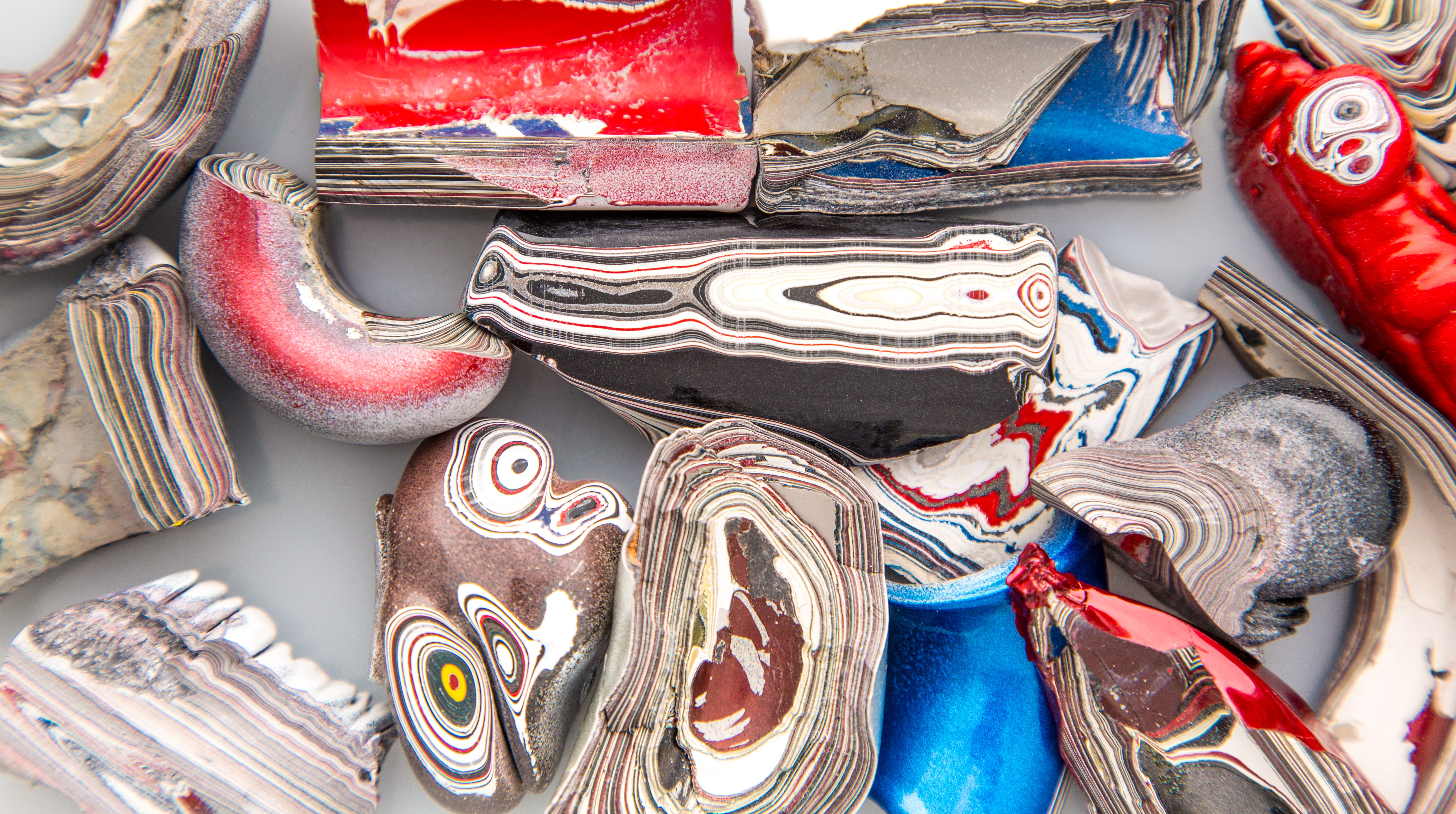The Anthropocene’s Best Gem Is Made Out of Old Car Paint
Sloppy automotive painting created some truly psychedelic jewels.

Agate gemstones are known for their amorphous, fluid patterns and colors created by the slow accumulation of sedimentary layers. But in the case of the obscure “gems” known as “motor agate” or “fordite,” instead of sediment and minerals, the layers are made of car paint.
Pieces of fordite certainly look as though they could have been fashioned deep within some colorful part of the Earth. Largely, though, fordite was created well above ground in the auto plants of Detroit, Michigan.
Beginning in the 1930s and 1940s, American automobiles began being painted via spray techniques that produced large nuggets of excess paint, built up in layer after layer of color. When the cars’ coating would be heated to harden, these overspray deposits would harden right along with them, bringing them to an almost stone-like hardness. A 2013 article about fordite in The New York Times refers to this excess as “enamel slag.”
Once these globs were sufficiently large enough to get in the way of the factory line, they would be broken off the bars and skids they were hanging from, and generally tossed away as waste. “Most of the good stuff is already buried in landfills,” says Cindy Dempsey, an independent jewelry creator and owner of Urban Relic Design, who has been working with motor agate for over 20 years.

According to a history of the material on Fordite.com, a site created by Dempsey, some auto workers with an eye for upcycling these colorful remnants cured them even further and cut them just like gem rocks. With a quick polish, chunks of motor agate became just as lovely as any naturally occurring mineral. And certainly more colorful.
The auto worker who originally gave Dempsey her first piece of fordite called it “paintrock.” On her site, Dempsey writes that she came up with the name “fordite” from a combination of Ford and the common mineralogical suffix “-ite.” “I thought I did, but I don’t know, because it ended up out there in the world,” she says. “I tried to trademark the name years ago, but Ford blocked my trademark.” As an alternative, she devised the name “motor agate.”
There are those who try to sell fake fordite. According to Karla Piper of Siesta Silver Jewelry, which makes jewelry and accessories out of pre-cut pieces of the material, people have tried to pass off recently fabricated fordite and even polymer clay as true Detroit agate. “Buyer beware,” she says.
Due to the nature of how vintage fordite was created, building up from layer after layer of different colored car enamel, fordite is often differentiated by the plant it came from, and the era in which it was created. Dempsey, who works with rough chunks, cutting and polishing cabochons from raw slag, looks to the color and even the smell of the material to identify true vintage fordite. “I can tell when it’s automotive paint,” she says. “There are certain eras of paint that have a certain sweet scent to them.”

Dempsey’s site identifies four varieties of motor agate, based on the way the layers end up falling and the way the colors are layered. One stand-out variety features layers of color that are separated by layers of grey primer. There are degrees of color-on-color fordite featuring more or less color variation, as well as layers of color that bleed into one another. For Dempsey, the heyday of fordite production was the 1970s, thanks to the wide variety of car colors on offer. After that, “the color of American cars really started to change and get more and more bland,” she says. “Now you notice, almost every car is silver, black, many colors of grey or gun metal, maybe dark blue, there’s an occasional weird orange. It’s very bland!”
By the 1980s, new painting processes began replacing messier, hand-held spray techniques, and once-abundant hunks of raw fordite became much more rare. But over the decades, both collectors and factory workers saved large amounts of the paint slag.
While the name “fordite” implies that the paint gems came mainly from Ford plants, it has also come to encompass any gem made of layers of hardened paint. Piper says she’s seen stones that were made from boat paint and appliance paint, though they don’t have the same mystique as true motor agate. “People would rather have a piece of a car than a piece of a refrigerator,” she says.
No one knows how much vintage fordite still exists, sitting in a box in someone’s garage or hoarded by some private collector. But it is widely available from sellers such as Dempsey and Piper, the latter of whom supplies the Detroit Institute of Arts with her wares. Fordite is literally a piece of American history that just accidentally dried in place, and for people like Piper, that’s what makes it special. “Being from Michigan, an automotive state, it’s part of our history.”









Follow us on Twitter to get the latest on the world's hidden wonders.
Like us on Facebook to get the latest on the world's hidden wonders.
Follow us on Twitter Like us on Facebook